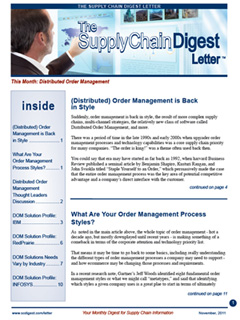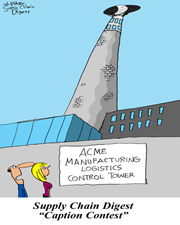 |
December 1, 2011 - Supply Chain Newsletter |
 |
This Week In SCDigest
FEATURED SPONSOR: Gartner-SCDigest |
|
|
|
Participate Now in this Important Study - Receive Complimentary Valuable Gartner Research - up to a $995.00 Value |
|

Distributing Order ManagementSuddenly, order management is back in style - but now of a "distributed" kind. Today, I will summarize some key points from our newest Supply Chain Digest Letter, this month on the very interesting topic of Distributed Order Management (DOM) systems. This really is one of the most dynamic areas of supply chain technology right now, for reasons I'll discuss below. Many of you should have or will shortly be receiving a hard copy of that Letter. But to download an e-version, and to find some excellent white papers, see related videos and more, go to our Distributed Order Management Resources Page. Throughout the mid-1990s to the early 2000s, order management was quite the hot topic. Part of that stemmed from a seminal Harvard Business Review article in 1992 called "Staple Yourself to an Order," by Benjamin Shapiro, Kasturi Rangan, and John Sviokla, which quite persuasively argued that "Every time a customer order is handled, the customer is being handled at the same time." The "stapling" part suggested that executives should literally follow an order as it moves across various functions and processes, from the time the customer first begins to show interest in a company's product or service, all the way through to after sale delivery and follow through. For many companies then and now, that can involve quite a large number of steps (the article itself offered 10 steps in the "order management cycle"). The article is still highly relevant some 20 years later.
Back in that late 1990s period, order management was a frequent topic of industry analysts, and there was lots of talk about "the order is king" and notions along those lines. Thousands of companies implemented new order management systems as part of larger ERP implementations - even if often taking a step back in functionality from the mainframe-based systems most had built over many years. Those were difficult and expensive to maintain, but they did exactly what the company needed them to do. (There are more of these original systems out there, even if front ended with a more modern user interface to replace the green screen, than many observers realize.) However, many companies had separate systems for each factory, and customers had to place orders at each facility, leading to separate invoices from each location. ERP was often implemented in part to solve that problem. So, in a greatly condensed version of the story, by about 2005 or so, most companies had placed their ERP bets, and the topic of Order Management dramatically dropped off as a matter of industry discussion and the technology priority list of companies. But also in the late 1990s, the roots of what we call today Distributed Order Management came into being. Actually, one of the true pioneers was a company called Yantra, which was later acquired by Sterling Commerce, which was in turn acquired by IBM, which is now one of the market's DOM leaders. Yantra was primarily trying to solve the problems of the e-commerce merchants, which often didn't carry any inventory themselves, but had to source and coordinate fulfillment across dozens of hundreds of suppliers, often in "drop ship" mode. But the e-commerce bubble burst. DOM solutions hung around, finding customers here and there, but struggled to gain critical mass. But over the last 2-3 years, that has started to change dramatically. Why? Three main reasons.
3. Increased Customer and Competitive Pressures: For a variety of reasons, such as virtualization, order management and fulfillment seem to just getting harder, while companies continue to push for greater inventory efficiency and fulfillment precision. Existing systems often just weren't very good at that. In retail, almost everyone is looking for more support for multi-channel strategies, with all the permutations of order online, pick-up in store, return anywhere, etc. Some articles, however, will position DOM as almost exclusively a retail phenomenon, but that is far from the case. Though the needs differ, companies in many industries - from service parts to consumer goods - have needs for and have deployed DOM technology. The full Letter has a nice sidebar on the needs for DOM by different sectors. What exactly does a DOM system do? Again it varies by industry, and I can't fully explain in the space I have here what we provide in the full 16-page Letter, but in great summary one can think of a DOM system as being a flexible order management engine that can capture or bring in orders from multiple channels or points of interaction (POIs), directly or indirectly, and then determine the best fulfillment strategy considering customer service commitments, inventory placements, shipping costs, and much more. The twin hearts or the system, if you will, should be the ability to model the full order lifecycle, and a powerful rules-engine in which order management and fulfillment process decisions can be defined for automatic execution. But there can be big differences across vendors in how both of these are handled. Yes, order management is back, and I think that's good to see. The order really is still king, whether it's "distributed" or not. Again, you'll find the Letter and much more at the Resources page. What do you think of DOM technology? Are you using it? Where do you see this headed? Let us know your thoughts at the Feedback button below.
|
|
New Videocast:
|
New Videocast:
|
New SCDigest Letter on Distributed Order Management Subscribe Now to Ensure You Receive a Mailed Hard Copy Mailing in a Few Days
|
We received a number of good letters on our First Thoughts piece on The 10 Dimensions of Supply Chain Excellence. That includes our Feedback of the Week from Jenny Kukoleva of United Stationers, who thinks ther eis a simpler approach.
Find her letter and other good ones below.
Feedback of the Week: On 10 Dimensions of Supply Chain Excellence:
There are actually a couple of systematic ways of assessing a supply chain that are well accepted and taught under the theory of the Supply Chain Management. They are Balanced Scorecard and the SCOR metrics. For example, the SCOR model uses the following metrics to assess and benchmark a supply chain: 1. Supply Chain Reliability - measured by Perfect Order Fulfillment rate; 2. Supply Chain Responsiveness - measured by Order Fulfillment Cycle time; 3. Supply Chain Flexibility - measured by # days required for the supply chain to achieve an unplanned sustainable X% increase/decrease in volumes delivered; 4. Supply Chain Costs - measured by the SCM costs as % of COGS; 5. Supply Chain Asset Mgmt - measured by Cash-to-Cash cycle time and Return on Supply Chain fixed assets) Would the above not work to evaluate one's supply chain excellence? I am not disagreeing with the 10 dimensions list in the article and definitely agree that SC structure needs to be aligned with the overall business strategy, but I think that the above metrics are a lot more measurable and actionable.
Jenny Kukoleva
|
||
More on 10 Dimensions:
|
||
Good article and I generally agree with the 10 dimensions you have listed with some nuances and comments.
10. Supply chain culture. This is the 800 pound gorilla in the room. Culture is largely invisible and extends across the entire organization, not just the supply chain. It is the hidden environment that defines how the organization works and how to stay out of trouble. Yes, culture can be set from the top, but do not underestimate how hard it is to change when an established culture is in place. As you work to develop a maturity model, you might want to take a look at some old references that may help with a framework. Two that come to mind are Logistical Excellence by Don Bowersox and others, 1992 and World Class Logistics, CLM, 1995. David Armstrong, Principal
|
||
| I enjoyed reading your article about the top 10 dimensions of Supply Chain Excellence. It is a worthy topic of discussion. You are right about Customer Satisfaction probably needing to be at the top of the list, just not on the list of dimensions. It is not a dimension, it is a measure, as you actually state in the article. You improve customer satisfaction and supply chain performance by implementing the other 9 dimensions. You can't action customer satisfaction in and of itself.
Paul Clark
|
||
| Your list of dimensions in supply chain excellence is great. I think you've captured all the high points especially the talent management. Those companies that undervalue that aspect usually aren't top performers.
As I have done many times in the past, I will cite your observations in my MBA class on Strategic SCM. Jack Ampuja
|
||
SUPPLY CHAIN TRIVIA ANSWER
Q: In the most recent Logistics Performance Index from the World Bank (2010), what were the top five countries in terms of that evaluation of logistics competence (infrastructure, customs, talent, etc.)?
A: (1) Germany; (2) Singapore; (3) Sweden; (4) Netherlands; (5) Luxembourg; the US ranked 15th.
| © SupplyChainDigest™ 2003-2011. All Rights Reserved. SupplyChainDigest PO Box 714 Springboro, Ohio 45066 |
POWERED BY: XDIMENSION |





